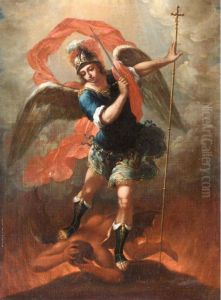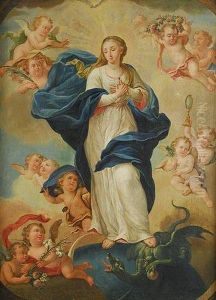Juan De Miranda Paintings
Juan de Miranda was a Spanish painter born in 1695 in Seville, Spain. He was an artist of the baroque period, which was characterized by dramatic expression, rich colors, and bold use of light and shadow. Miranda's work, while not as widely recognized as some of his contemporaries, contributed to the rich tapestry of Spanish art during a period that produced many of Europe's great masters.
Miranda studied painting in Seville under the tutelage of Domingo Martinez, a prominent painter of that time. Under Martinez's guidance, Miranda honed his skills in religious subjects, which were particularly in demand for the decoration of churches and for private devotional objects. His style was deeply influenced by the prevailing Baroque sensibilities of the period, yet he also demonstrated a certain individuality in his approach to composition and color.
Throughout his career, Juan de Miranda enjoyed a modest level of success. He worked primarily on commissions for religious institutions, creating altarpieces, frescoes, and oil paintings that depicted various scenes from the Bible and the lives of saints. His work was characterized by careful attention to detail and a particular finesse in rendering the human figure, imbuing his subjects with a sense of piety and grace.
Despite the quality of his work, Miranda did not achieve the same level of fame as some of his peers, such as Bartolomé Esteban Murillo or Francisco de Zurbarán, whose works have overshadowed many of their contemporaries. Nonetheless, Miranda's paintings can still be found in certain churches and museums, where they continue to be appreciated for their contribution to the Spanish Baroque movement.
Juan de Miranda's life was largely spent in his hometown of Seville, where he passed away in 1776. Although the details of his personal life are not extensively documented, his surviving works serve as a testament to his skills and his dedication to his art. Today, art historians acknowledge Miranda as a noteworthy figure within the Spanish Baroque tradition, and his paintings remain a subject of study for those interested in this flourishing period of Spanish art history.

